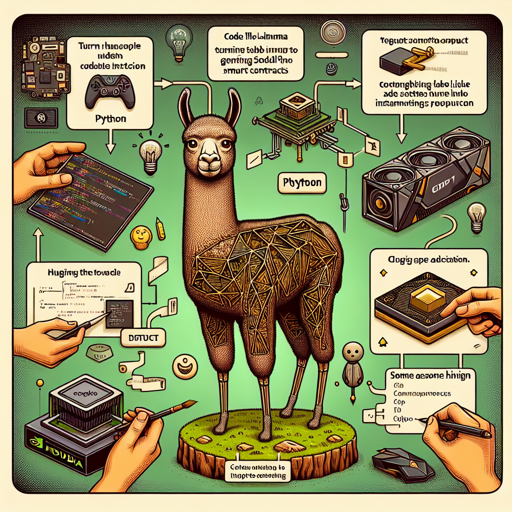In today’s blog post, we’ll explore how to utilize the finetuned Code LLaMA 7B Instruct model to generate Solidity smart contracts efficiently. This guide is meant to be user-friendly, even for those who may be new to programming or the world of smart contracts.
What You Will Need
- Python installed on your machine
- The Hugging Face Transformers library
- An NVIDIA GPU to accelerate training and execution
Understanding the Model
The Code LLaMA 7B Instruct model is designed to generate Solidity smart contracts based on human-like instructions. Think of it like a highly knowledgeable assistant that takes your commands and crafts a precise letter (in this case, a smart contract), following all the required formalities and structure.
Setting Up the Environment
Before diving into the code, you need to set up your environment with the necessary libraries. Run the following commands:
pip install transformers torch accelerateLoading the Model
To get started with generating a smart contract, we first need to load the model and the tokenizer:
from transformers import BitsAndBytesConfig, AutoTokenizer, AutoModelForCausalLM
import torch
import accelerate
use_4bit = True
bnb_4bit_compute_dtype = "float16"
bnb_4bit_quant_type = "nf4"
use_double_nested_quant = True
compute_dtype = getattr(torch, bnb_4bit_compute_dtype)
# BitsAndBytesConfig 4-bit config
bnb_config = BitsAndBytesConfig(
load_in_4bit=use_4bit,
bnb_4bit_use_double_quant=use_double_nested_quant,
bnb_4bit_quant_type=bnb_4bit_quant_type,
bnb_4bit_compute_dtype=compute_dtype,
load_in_8bit_fp32_cpu_offload=True
)
# Load model in 4-bit
tokenizer = AutoTokenizer.from_pretrained("AlfredPros/CodeLlama-7b-Instruct-Solidity")
model = AutoModelForCausalLM.from_pretrained("AlfredPros/CodeLlama-7b-Instruct-Solidity", quantization_config=bnb_config, device_map="balanced_low_0")Making a Smart Contract
Now that we’ve loaded the model, it’s time to input your specific contract requirements. Just like requesting a letter, you will provide the details of your smart contract.
# Make input
input = "Make a smart contract to create a whitelist of approved wallets. The purpose of this contract is to allow the DAO (Decentralized Autonomous Organization) to approve or revoke certain wallets, and also set a checker address for additional validation if needed. The current owner address can be changed by the current owner."
# Make prompt template
prompt = f"""
### Instruction:
Use the Task below and the Input given to write the Response, which is a programming code that can solve the following Task:
### Task:
{input}
### Solution:
"""
Generating the Contract
With our input prepared, we can now generate the Solidity code:
# Tokenize the input
input_ids = tokenizer(prompt, return_tensors="pt", truncation=True).input_ids.cuda()
# Run the model to infer an output
outputs = model.generate(input_ids=input_ids, max_new_tokens=1024, do_sample=True, top_p=0.9, temperature=0.001, pad_token_id=1)
# Detokenize and display the generated output
print(tokenizer.batch_decode(outputs.detach().cpu().numpy(), skip_special_tokens=True)[0][len(prompt):])Troubleshooting Common Issues
If you encounter issues during the process, here are a few troubleshooting tips:
- Model Not Loading: Ensure you have the right model identifier. Check that you loaded the model called “AlfredPros/CodeLlama-7b-Instruct-Solidity”.
- Errors Related to GPU: Confirm that you have the required CUDA drivers installed and that your GPU is compatible.
- Performance Issues: If the model runs slowly, try reducing the complexity of your input or check your system resources.
For more insights, updates, or to collaborate on AI development projects, stay connected with fxis.ai.
Conclusion
With the Code LLaMA 7B Instruct model, generating Solidity smart contracts can be seamless and highly efficient. This technology opens up various possibilities to facilitate the DAO and streamline various blockchain applications.
At fxis.ai, we believe that such advancements are crucial for the future of AI, as they enable more comprehensive and effective solutions. Our team is continually exploring new methodologies to push the envelope in artificial intelligence, ensuring that our clients benefit from the latest technological innovations.

